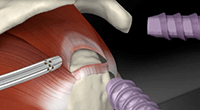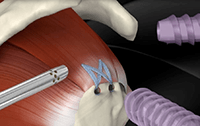What is a Rotator Cuff Tear?

A Rotator Cuff tear is a detachment of the tendon from the humeral head. The rotator cuff is the group of tendons whose muscles act to center and stabilize the humeral head in the shoulder socket. They provide power to assist in rotation and elevation to the shoulder joint. Rotator cuff tears may be partial or complete.
What causes Rotator Cuff Tears?
Rotator cuff tears may result from trauma, such as motor vehicle accidents or falls onto the shoulder or outstretched hand. Patients with occupations that frequently require them to lift their arms over their heads, such as plumbers, painters, electricians and carpenters, are particularly at risk. Lifting a heavy object may lead to a tear. Athletes who play overhead sports, such as baseball, softball, volleyball and tennis may develop tears. Older patients who dislocate their shoulder will frequently tear their cuffs. In some patients, the rotator cuff will tear due to age-related wear without an identified incident.
What are the symptoms?
Patients will complain of pain in the outside portion of the shoulder, especially at night. They point to the anterolateral area of the deltoid muscle. Although the problem is deep inside the shoulder joint, the brain interprets the pain as coming from lower down in the arm. Patients will have pain with overhead lifting, or with rotating the arm, such as reaching for a wallet, or unhooking a bra strap. Patients with larger tears will have a loss of strength or be unable to lift the affected arm. Patients may also complain of clicking or popping when moving the shoulder.
How is a Rotator Cuff Tear diagnosed?
Your surgeon will take a history of your shoulder pain and perform a physical examination. On exam, patients typically demonstrate weakness with elevation and rotation of the arm.
X-ray may show indirect signs of a tear. An Ultrasound or an MRI scan will confirm the tear.
How is it treated?
Non-operative
Non-operative treatment can be attempted in patients with partial tears of the rotator cuff, or small tears with minimal symptoms. Physical therapy, anti-inflammatory medication or cortisone injections into the space just above the cuff may alleviate pain. Patients whose pain does not resolve with non-operative treatment should undergo surgery.
Operative
Tears in which the tendon has detached from the bone should be surgically repaired, as they cannot heal on their own. This operation is performed arthroscopically (keyhole). The cuff is sutured and pulled back to its original attachment and is held in place using sutures connected to anchors.

Partial tears that fail to improve with non-operative treatment should be evaluated arthroscopically. If a partial tear involves more than 50% of the tendon, a repair should be performed. If the tear is less than 50% of the tendon, than the injured tissue can be trimmed and more space for the cuff created by removing some bone over the top of the cuff. This is called 'subacromial decompression', because the bone is removed from the undersurface of the acromion. Following a procedure, your surgeon will recommend a sling to protect the repair while it heals, and start physical therapy to regain motion and strength in the shoulder.
 Loading...
Loading... 


 Arthroscopic
Arthroscopic



